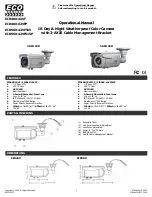
Linea SWIR GigE Camera Quick Start Guide
10
Teledyne DALSA
03-032-20284-02
A line profile is mainly determined by two factors: Flatness and Height
1) Flatness:
The Line profile represents a Flat Field measurement. Due to lens-shading effect, light falls-off
near the edges and results in lower output. This produces higher noise levels near the edge. A smaller
aperture opening and longer focal length can reduce lens - shading effect. In some demanding applications,
optimized low - shading lenses should be considered.
2) Height:
An average value near your calibration target is ideal.
An extremely low output compared to the target will increase noise level significantly after the PRNU is
corrected. To avoid SNR and / or DNR not meeting your application requirements, the profile should reach a
level near the calibration target.
NOTE:
Changes to gain do not improve image quality from a SNR perspective. Gains are analog and digital
multipliers that scale up signal and noise proportionally.
Before performing a FFC keep the following in mind:
•
Ensure the camera’s temperature is at nominal operating condition. Power-on for minimum 30 min.
•
All parameters should meet your application’s specifications. If parameters change after FFC completion,
the results may no longer be accurate. Perform another FFC.
FPN Correction
Step 1:
Cover the lens (place the sensor in black).
Step 2:
Select
Off
from Flat Field Correction Mode drop-down menu and check the line profile / histogram. If
pixel outputs are zero, adjust the “Black level (in DN)” to increase Minimum value above zero. The Black
Level adjustment is located in the Sensor Control category.































